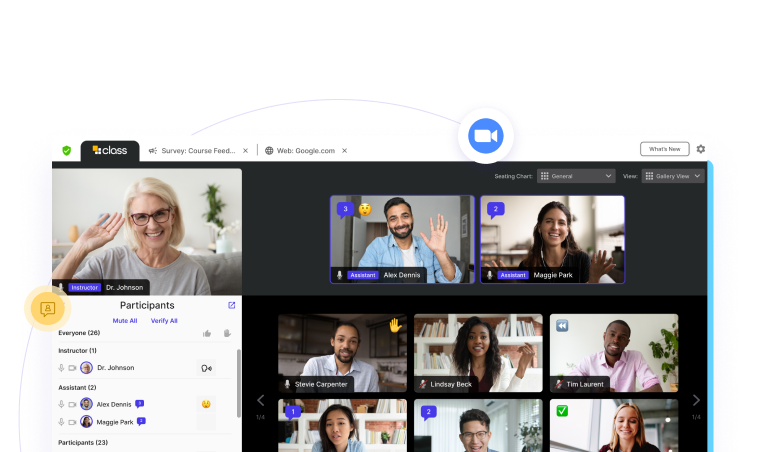
Christy O’Glee works as an Account Executive at Class after spending a decade in education. She is passionate about increasing educational opportunities for K12 students through innovative technology. When not working, she can be found traveling and spending time with her family.

Christy O’Glee works as an Account Executive at Class after spending a decade in education. She is passionate about increasing educational opportunities for K12 students through innovative technology. When not working, she can be found traveling and spending time with her family.

K-12 schools often invest in new EdTech tools hoping to boost engagement, productivity, and outcomes. But as these tools pile up, they often lead to confusion, overlapping features, and wasted budget.
It doesn’t have to be this way.
A modern, integrated EdTech stack brings everything together, reducing friction, enhancing security, increasing visibility, and improving both teaching and learning. Let’s explore how a unified approach to EdTech can save time, stretch budgets, and improve outcomes across the board.
EdTech bloat is real. Schools often pay for multiple tools with similar features, or invest in platforms that are underutilized due to poor interoperability. That’s wasted money.
An integrated stack minimizes redundancy by focusing on tools that work together. The result is that every dollar you spend drives greater value.
A simplified stack also reduces the burden on your IT and teaching staff. With fewer tools to manage, IT teams can maintain systems more effectively, while teachers spend less time juggling logins or navigating different interfaces and more time with students.
An integrated EdTech ecosystem improves more than efficiency, it strengthens security. With centralized user management and single sign-on (SSO), you can:
When tools talk to each other, data becomes more powerful. Instead of pulling reports from separate systems, a connected stack gives administrators and teachers a holistic view of:
These insights allow for quicker intervention, more personalized instruction, and smarter decisions across classrooms and districts.
With a 360-degree view of each student, educators can tailor learning experiences that better meet individual needs. Integrated systems surface patterns—struggles, strengths, and preferences—before issues become major setbacks.
Fewer logins and tool-switching means fewer distractions. Especially for younger students, consistent user experiences across tools help them stay focused and confident in the digital classroom. In-app communication tools also make it easier for teachers and students to connect without jumping between platforms.
Every district relies on technology, but the difference between a stack that supports your goals and one that slows you down often comes down to how well those tools work together.
A streamlined, integrated EdTech stack helps reduce costs, improve security, simplify management, and support better outcomes for students and educators alike. When tools are intentionally selected and seamlessly connected, they create a cohesive system that supports instruction, not one that distracts from it.
Whether you're refining your existing stack or planning a broader transformation, a connected approach can deliver the clarity and control today’s K-12 systems need.
Ready to explore what that looks like for your district? Reach out to a Class team member to start the conversation. And if you haven’t already, be sure to download the 2025 Guide: Maximizing Impact With a Connected K-12 EdTech Ecosystem for a deeper look at the strategies behind a more effective stack.
A: Integrated EdTech systems simplify user management and reduce security risks by centralizing access controls. Features like single sign-on (SSO) allow administrators to manage user permissions across platforms from one location, ensuring that only authorized individuals can access sensitive student data. This streamlining supports compliance with key privacy regulations such as FERPA, COPPA, and state-level mandates by minimizing opportunities for error and data exposure. Additionally, integration makes it easier to monitor activity and enforce policies consistently, providing peace of mind for IT teams and school leaders alike.
A: Yes, and often, fewer integrated tools can lead to better personalization. When your tools are connected, data flows seamlessly between them, giving educators a unified view of each student’s progress, strengths, and challenges. This enables teachers to adapt instruction based on real-time insights rather than pulling reports from multiple disconnected platforms. Integrated systems also reduce friction for students, allowing them to engage more consistently with learning content tailored to their needs. With the right stack, schools can achieve more effective differentiation without relying on a patchwork of one-off solutions.
A: Start by auditing your existing tools to uncover redundancies, underutilized platforms, and integration gaps. Involve key stakeholders—especially educators and IT staff—to identify pain points and instructional priorities. As you evaluate new solutions, look for vendors that offer strong integration capabilities and a commitment to partnership. The right providers will support you through implementation, offer responsive customer service, and help align their tools with your long-term goals. A phased rollout with hands-on support and training ensures a smoother transition and better adoption.

Christy O’Glee works as an Account Executive at Class after spending a decade in education. She is passionate about increasing educational opportunities for K12 students through innovative technology. When not working, she can be found traveling and spending time with her family.

Christy O’Glee works as an Account Executive at Class after spending a decade in education. She is passionate about increasing educational opportunities for K12 students through innovative technology. When not working, she can be found traveling and spending time with her family.
Get our insights, tips, and best practices delivered to your inbox

Sign up for a product demo today to learn how Class’s virtual classroom powers digital transformation at your organization.

Features
Products
Integrations